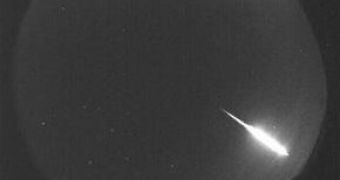On the evening of March 5, Wednesday, the Physics and Astronomy Department at Western Ontario University received a number of calls and e-mails from people claiming to have been a bright streak of light crossing the sky sometime around 10:59 p.m. EST. Luckily, the astronomy department is equipped with a network of all-sky cameras specially designed to scan the night sky for evidence of falling meteors, thus becoming the only astronomical institution to have filmed the unique event.
According to associate professor Peter Brown, the cameras have been able to obtain images of the falling meteor, showing how a large fireball of light crosses the sky, right before the astronomy department received warnings from the people living in the surrounding areas. The next step is finding the remnants of the meteor, says Wayne Edwards, a doctorate student of the University of Western Ontario, Canada. He believes that with the help of a couple of local residents, the possible remnant fragments of the meteorite can be found. It is widely believed that it could have crashed in the surrounding area of Parry Sound, Ontario.
Edwards writes that, usually, meteoroids don't reach altitudes lower that 60 to 70 kilometers above the surface of the Earth, but some, including this one as well, may reach altitudes as low as 24 kilometers. Thus, there is a good chance that it did not burn completely during the entry into the Earth's atmosphere, and multiple fragments may still be laying in the ground next to the impact location.
Preliminary calculations indicate a possible area of about 12 square kilometers where the meteoroid might have impacted the ground. It may weigh as much as one kilogram and consist of one or more fragments of rock. Edwards says that in order to assist the search, the laboratory provided a map that would help locate the meteorite.

 14 DAY TRIAL //
14 DAY TRIAL //